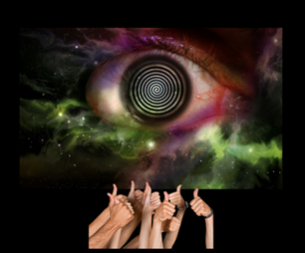Are EMDR and Hypnotherapy Competing or Complementary Modalities?
As therapists have become more attentive to trauma-informed approaches to therapy, EMDR (Eye Movement Desensitization and Reprocessing) and Hypnotherapy have emerged as significant and effective tools. While most therapists are trained in one or the other, there is much to be gained by looking at how the two modalities can work together to help clients suffering from PTSD and other issues.
Both EMDR and Hypnotherapy facilitate communication between conscious awareness and subconscious memory. When a traumatic event occurs, the person goes into psychological shock, and frequently suppresses the conscious memory of the traumatic event.
In these cases, the mind doesn’t process the event. Buried in the subconscious, or stuck in the midbrain, the memory creates a constant state of distress. It is almost as though the traumatic event is occurring all of the time. The memory of the upsetting set of circumstances can also be triggered by random stimuli in the environment. The memory comes up state specific, or just as it was when it happened.
By connecting the conscious part of the person’s awareness with subconscious and suppressed memories, it is possible to allow the client to process the event and the emotions surrounding it. Once the event is reframed or reprocessed, the client gets an opportunity to live in freedom from the unregulated re-emergence of the traumatic memory. They can see the event in their “rear view mirror” but it is a neutral memory.
How do EMDR and Hypnotherapy differ?
Before listing the distinctions between EMDR and Hypnotherapy, it is useful to point out that both techniques are extremely effective at bringing about the unconscious into consciousness. Thus the EMDR therapist is able to enable the client to put the traumatic event in the past, no longer revisiting the memories at random times, and going back into the state of distress they once experienced.
EMDR is a well-researched, evidenced-based psychotherapy model. Through bilateral stimulation via eye movements or other stimuli, the client’s brain is able to make connections between a target memory or impression and the past event(s) that produced it.
The client is given resources to use in the event the experience becomes too intense, such as putting negative thoughts in an imaginary container or visualizing a healing light. When processing the traumatic memories, the client is encouraged to access the distressing memory. The process of desensitization begins. Clients are encouraged to access traumatic memories, express the emotions that came up at that time, but were unable to be expressed. Using bilateral stimuli and further reprocessing the client is no longer distressed about the memory and views themselves differently both affectively and somatically.
Hypnosis has long existed and has been used in one form or another to help people access the subconscious mind. In hypnotherapy, the client is induced into a relaxed state, or trance. This enables the client to relax enough to be able to get in touch with the emotions underlying their distress, and then to make connections with past experiences. This process can assist the client to access the traumatic memories to be reprocessed with EMDR.
There is also time given for the client to begin to re-parent, by embracing younger versions of the self and giving them the attention and love they didn’t get when the trauma occurred. Hypnotherapy evokes emotions on a very deep level and promotes healing through release of these emotions. EMDR also focuses on present triggers and the future.
How EMDR and Hypnotherapy can work together
Each client comes to therapy with different needs and a different set of fears and inhibitions. EMDR can be quite effective in opening a client to the past to access the source of symptoms. EMDR is much easier to present to those clients who prefer not to describe traumas in detail and the trauma memory can be reprocessed “blind to the therapist”.
Hypnotherapy can be introduced to clients at varying states of resistance as well, by using a titration process. However, clients benefit most from hypnotherapy when they are ready to experience their emotions with a feeling of safety and trust that the therapist builds with them. Hypnotherapy may take the experiences revealed in an EMDR session and allows the client to experience them more deeply and completely. EMDR benefits from the clients ability to access the trauma and manage the window of tolerance in reprocessing.
Fortunately, you can learn everything you need to know in order to conduct full and complete EMDR sessions through the EMDR Basic Training Course at The Wellness Institute.
You will learn about EMDR Therapy, and experience conducting your own EMDR work during the Six Day EMDR Therapy Basic Training Program at The Wellness Institute. All sessions are conducted live and online, with experienced teachers who will guide you through your learning process. Seasoned EMDR Therapists from all over the country will assist you as you practice in small groups, as therapist, observer, and client.
One of the biggest advantages of learning EMDR Therapy at The Wellness Institute is the way that you will benefit from the technique from the perspective of a client. You will get to do your own transformational work while you and others learn more and more about what this powerful modality has to offer.
Unlike many other training schools, The Wellness Institute has a lot of room for you to grow, in terms of both your clinical skills and your personal development. Our advanced programs allow you to deepen your insight and develop your talents on levels that will increase your confidence as well as your competence as a EMDR Therapist and Hypnotherapist.
For those who need an Introduction to Hypnosis, TWI will provide the basics. Learn how to conduct hypnosis sessions to motivate clients, help them deal with pain and anxiety, and assist them in furthering their personal growth.
The Wellness Institute offers the perfect solution for therapists who want to go deeper with their clients. Learn EMDR Therapy or hypnotherapy, right from the comfort of your own home or office.
Enroll in the
Six Day Hypnotherapy Training and Certification Program
or the
Introduction to Hypnosis Course
Today!









